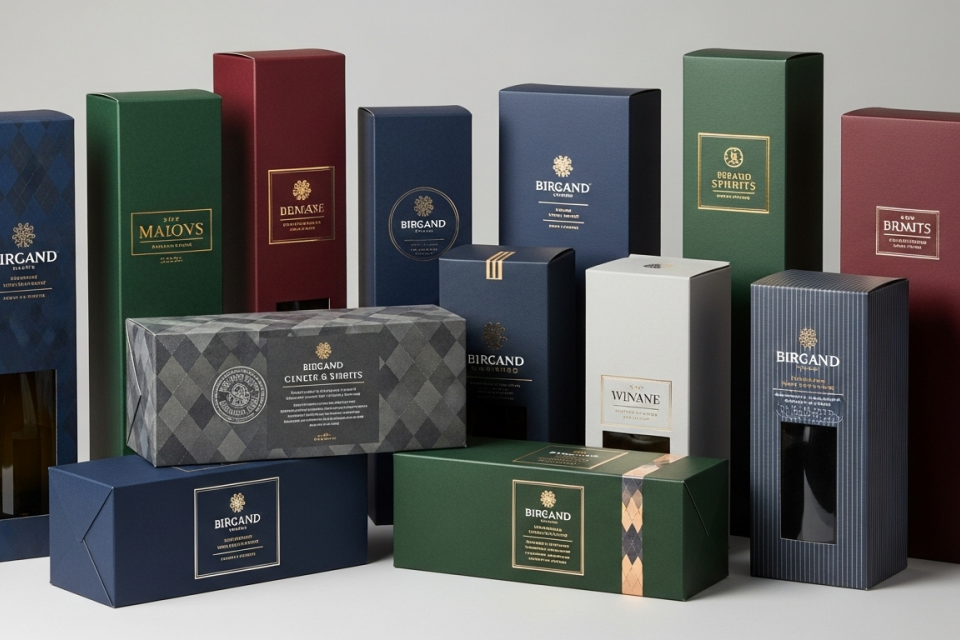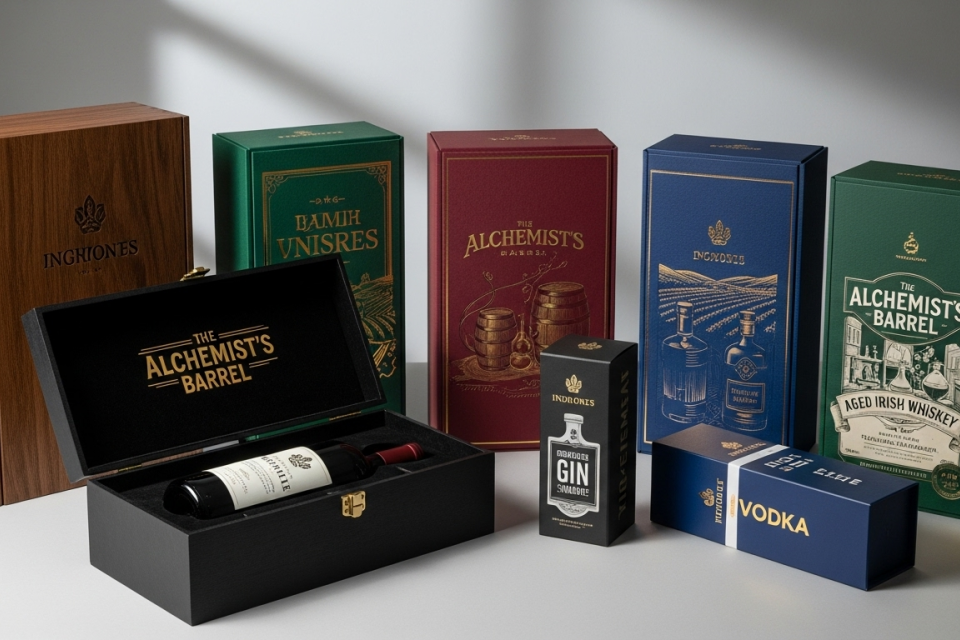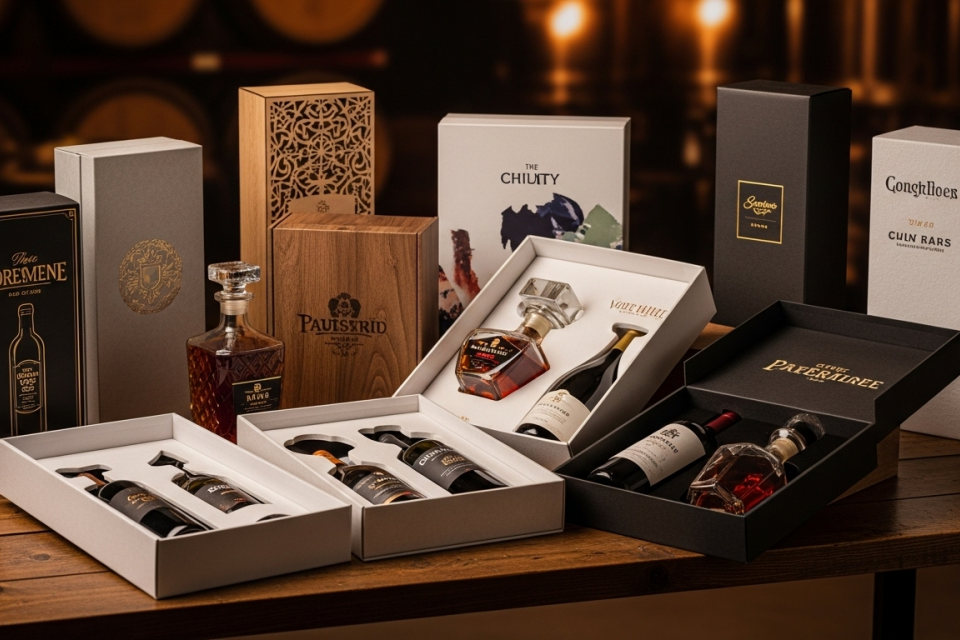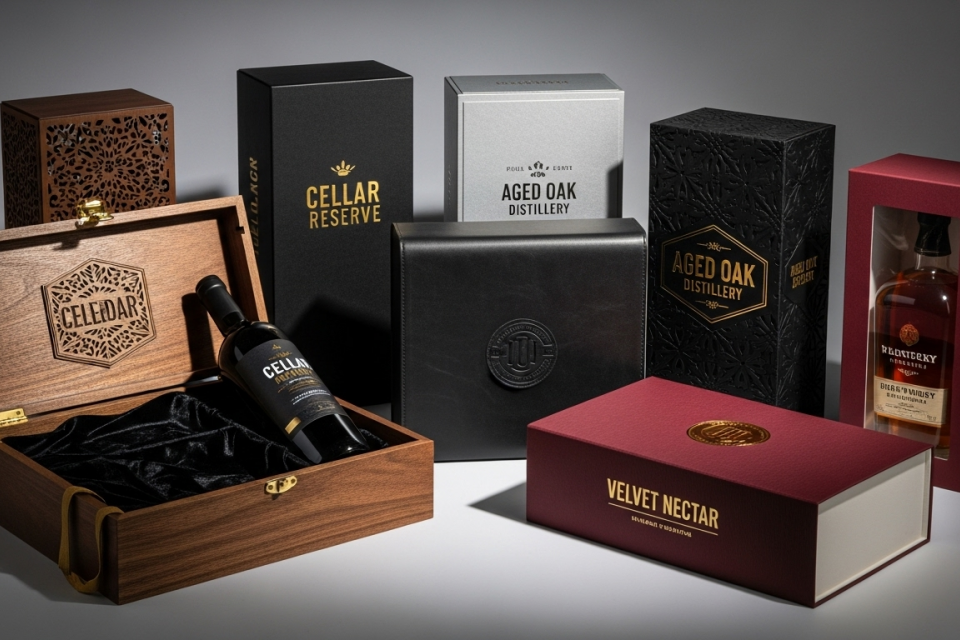The Importance of Wine Spirits Packaging
This blog explores the vital role of wine and spirits packaging, from materials and design to sustainability and its powerful influence on consumer behavior.
Summary
The Importance of Wine Spirits Packaging is a critical aspect of the alcoholic beverage industry, encompassing a diverse range of materials and designs that protect products while enhancing brand identity. Effective packaging serves multiple purposes, including safeguarding the contents, facilitating transportation, and appealing to consumers’ preferences, which are increasingly shaped by sustainability concerns and aesthetic values. The significance of packaging in wine and spirits extends beyond functionality, influencing consumer behavior and brand perception in a competitive market.
Notably, the packaging of wine and spirits has evolved significantly, with traditional glass bottles dominating for their preservation qualities, while newer innovations like bag-in-box, Tetra Pak, and eco-friendly materials are gaining traction. Each of these packaging types presents unique advantages and aligns with modern consumer preferences for convenience and environmental sustainability. The shift toward alternative packaging solutions reflects broader trends in the industry, where sustainability has become a paramount consideration for both producers and consumers alike.
Additionally, the packaging design process is increasingly driven by consumer behavior, emphasizing emotional engagement and clarity in messaging. Research indicates that external characteristics, including color, typography, and material choice, heavily influence purchasing decisions, reinforcing the importance of thoughtful packaging strategies in brand differentiation and market success. As the industry faces regulatory pressures regarding labeling and environmental impact, companies must navigate compliance challenges while innovating to meet the evolving expectations of eco-conscious consumers.
In summary, the importance of wine spirits packaging is underscored by its multifaceted role in product protection, consumer engagement, and sustainability. The ongoing evolution in materials and designs not only reflects changing consumer demands but also positions brands strategically within a rapidly transforming market landscape.
Table of Contents
Types of Wine Spirits Packaging
Common Packaging Materials
Wine and spirits packaging utilizes a variety of materials, each offering unique benefits that cater to the needs of both producers and consumers. Cardboard and paper have long been favored for their lightweight yet sturdy nature, providing excellent protection for delicate contents while allowing ample space for branding and information. Molded pulp, crafted from recycled paper and cardboard, is another popular sustainable option that minimizes environmental impact while offering cushioning and branding possibilities during transit.
Glass Bottles
Glass remains the most popular choice for packaging wine and spirits due to its chemical inertness, which ensures that the product’s taste, aroma, and quality are preserved over time. Glass bottles offer superior gas and vapor barrier protection, stability, and transparency, making them ideal for a variety of products, including aged spirits and fine wines. The versatility in design of glass packaging allows brands to create distinct identities through customized shapes and embossed logos, which helps products stand out on crowded shelves.
Bag-in-Box
The bag-in-box system is a flexible packaging solution that consists of a collapsible inner bag housed within a rigid outer box. This packaging method, often used for medium-quality table wine, protects the product from oxygen exposure by collapsing as wine is dispensed. Bag-in-box packaging is available in sizes typically ranging from 3L to 5L, making it a practical option for consumers seeking value without compromising quality.
Tetra Pak
Tetra Pak cartons are increasingly being adopted by wine producers as a lightweight alternative to traditional glass bottles. This packaging solution is made from a combination of paperboard, polyethylene, and aluminum, which protects the contents from external factors while allowing for efficient transportation. Tetra Pak products are available in various sizes, including single-serving options, and are notably less expensive to produce and ship compared to glass.
Kegs
Wine on tap, stored and served from plastic or steel kegs, offers a sustainable option that reduces waste and improves margins for businesses. Kegged wine has gained popularity as a greener way to serve wine, especially in bars, where it can be paired with beer taps, enhancing brand visibility. This method not only reduces the carbon footprint but also allows for cost-effective purchasing compared to bottled wine.
Alternative Packaging Innovations
Recent developments have introduced innovative alternatives such as flat bottles made from recycled PET (rPET). These bottles can optimize space during transportation by allowing for more product per pallet, while still maintaining the quality and appearance of traditional glass bottles. Such innovations reflect the ongoing trend toward sustainability in wine and spirits packaging, as producers seek to balance functionality with environmental responsibility.

Design Considerations
Emerging Trends in Packaging Design
As the digital age progresses, staying abreast of emerging trends in packaging design becomes crucial for brands to maintain relevance in a competitive market. Key trends include minimalism, augmented reality, and customization, each serving to enhance brand identity and consumer engagement. Minimalism focuses on simplicity and clarity, allowing brands to communicate their messages effectively while maintaining aesthetic appeal. Augmented reality (AR) introduces interactive elements, enabling consumers to engage with packaging through their smartphones, which can enhance the overall customer experience. Customization enables packaging to reflect a brand’s identity while resonating with consumers, particularly in premium markets such as wines and spirits.
Sustainability Considerations
Sustainability is a significant consideration in modern packaging design. Packaging engineers are increasingly developing eco-friendly solutions that minimize environmental impact. This includes the use of recyclable or biodegradable materials and optimizing packaging dimensions to reduce waste. Brands are also gravitating toward lightweight and on-the-go packaging options made from materials like aluminum and paper-based solutions, aligning with circular economy goals. This trend not only appeals to environmentally conscious consumers but also offers practical benefits in terms of portability.
Label Design and Consumer Engagement
The design of labels plays a critical role in captivating consumers and differentiating products within the crowded alcoholic beverage market. A well-designed label can effectively communicate a brand’s identity while drawing attention on store shelves. Strategic design elements such as color, typography, and imagery are vital in evoking emotions and building brand recognition and loyalty. Brands must balance aesthetic appeal with essential information, ensuring that labels remain engaging without overwhelming consumers.
Custom Packaging Solutions
Custom packaging is a multifaceted endeavor that aims to provide safety, ease of access, and environmental consciousness, all while narrating a brand’s story. Effective custom packaging protects products, facilitates user interaction, and demonstrates a brand’s commitment to sustainability. For instance, premium products like wines and spirits often utilize elegant packaging that not only reflects quality but also enhances the overall consumer experience.
The Role of Consumer Behavior
Understanding consumer behavior is integral to effective packaging design. Research indicates that the external characteristics of products, such as packaging and labels, significantly influence purchasing decisions. Neuroscientific studies have shown that preferences can be detected in brain activity prior to final decision-making, highlighting the importance of design in capturing consumer attention. Thus, packaging must not only be visually appealing but also align with the emotional and practical preferences of consumers.

Regulatory Aspects
The packaging of wine and spirits is significantly influenced by various regulatory requirements that govern labeling, safety, and environmental standards. In the United States, the Alcohol and Tobacco Tax and Trade Bureau (TTB) oversees the Federal Alcohol Administration Act, establishing strict labeling guidelines for alcoholic beverages. These regulations ensure that products meet both domestic and international standards, impacting how companies design their packaging to comply with these laws.
Environmental Regulations
With increasing awareness of environmental issues, regulatory frameworks are evolving to address sustainability in packaging. Many U.S. states are implementing policies aimed at enhancing recycling efficiency and minimizing waste through initiatives such as Extended Producer Responsibility (EPR) programs and minimum recycled content requirements. These regulations compel beverage companies to innovate and adapt their packaging strategies to meet new environmental standards. For example, the adoption of sustainable materials and practices is becoming essential as consumers demand more eco-friendly packaging options, which can also enhance a brand’s market position.
Labeling Requirements
Alcoholic beverages are subject to specific labeling requirements that convey vital information to consumers. For instance, labels must include the alcohol by volume (ABV) percentage, the origin of the product, and health warnings. Additionally, beverages with an ABV below 7% are regulated by the Food and Drug Administration (FDA), which enforces different labeling criteria. The design of these labels not only fulfills legal obligations but also plays a crucial role in brand differentiation and consumer attraction. Packaging engineers are tasked with creating labels that adhere to regulations while remaining visually appealing and informative.
Compliance Challenges
Companies in the wine and spirits industry face challenges related to compliance with both packaging and environmental regulations. The need for proper recycling infrastructure and the prevalence of material contamination can complicate the compliance landscape, particularly in developing regions. Non-compliance can lead to financial repercussions, including penalties and lost market opportunities. Conversely, businesses that embrace sustainable practices often benefit from enhanced brand reputation and customer loyalty, reflecting the shifting preferences of consumers who are increasingly focused on sustainability.

Marketing and Consumer Perception
The packaging of wine and spirits plays a critical role in shaping consumer perceptions and influencing purchasing decisions. It serves not only a functional purpose—protecting the product—but also acts as the brand’s visual representative, encapsulating its essence and values even before the consumer has the chance to taste it. A well-designed package captures attention in crowded retail spaces and creates a lasting first impression, thereby serving as a bridge between the brand’s narrative and the consumer experience.
The Role of External Characteristics
Research indicates that consumer preferences for products, especially in categories like wine, are significantly affected by external characteristics such as packaging, label design, and price. Consumers often rely on these visual cues when they lack familiarity with the product or when they cannot assess its internal attributes. This is particularly prevalent among wine buyers, who frequently choose their selections based on external features. Investigating how these factors influence consumer behavior can help marketers differentiate their products and tailor strategies to enhance visual appeal.
Emotional and Psychological Influences
Packaging color is known to evoke specific emotional responses and can significantly shape consumer perceptions. Colors such as black suggest elegance, while gold implies luxury, and green signals sustainability, each influencing buyer behavior on a subconscious level. High-quality visual elements, including graphics and layout, enhance product desirability and connect consumers to the brand’s identity, reinforcing marketing messages and driving purchasing behavior.
Furthermore, consumer neuroscience studies suggest that preferences may be reflected in brain activity prior to a purchase decision, highlighting the importance of capturing visual attention early in the buying process. By leveraging neuroscientific insights, marketers can better understand how external characteristics affect consumer preferences and decision-making.
Creating a Memorable Experience
The unboxing experience is another crucial aspect of packaging that extends the brand’s impact beyond the initial purchase. A captivating packaging design can foster emotional connections, enhancing customer loyalty and transforming the product into a memorable experience. Brands that invest in creating a premium and engaging packaging experience elevate their market presence, distinguishing themselves from competitors in a crowded marketplace.
Moreover, as consumer expectations evolve, especially regarding sustainability, packaging engineers are increasingly tasked with developing eco-friendly solutions that minimize environmental impact. This includes using recyclable materials and optimizing packaging design to reduce waste, aligning with the values of modern consumers who prioritize sustainability in their purchasing decisions.

Environmental Impact
The production and packaging of alcoholic beverages have historically been associated with significant environmental impacts. The adult beverage industry contributes to high energy consumption, substantial water usage, waste generation, and carbon emissions throughout the manufacturing and distribution processes. However, the industry is undergoing a transformation, driven by the need for sustainable practices to mitigate these adverse effects and cater to an increasingly eco-conscious consumer base.
The Need for Sustainable Practices
As awareness of environmental issues grows, the alcohol industry is recognizing its ecological footprint. Factors such as regulatory pressures, industry guidelines, and consumer demand for eco-friendly products are prompting a shift towards sustainability. The implementation of sustainable practices not only reduces environmental harm but also enhances brand reputation and consumer loyalty, as modern consumers prefer brands that prioritize sustainability.
Sustainable Packaging Innovations
Sustainable packaging is a crucial component in minimizing the environmental impact of alcoholic beverages. Traditional packaging methods often involve excessive use of single-use materials, contributing to substantial waste generation. In contrast, eco-friendly packaging alternatives, such as biodegradable plastics, recycled paper, and plant-based fibers, are increasingly being adopted to reduce waste and carbon footprints. These materials are not only sustainable but also visually appealing, helping brands to attract environmentally conscious consumers.
The market for sustainable packaging in the food and beverage sector is projected to exceed 100 billion USD in the coming years, indicating a significant shift towards more eco-friendly solutions. Innovations in lightweight packaging, such as aluminum and rPET (recycled polyethylene terephthalate), further reduce shipping costs and materials required, enhancing profitability while supporting sustainability goals. Additionally, the use of single-material designs improves recyclability, and advancements in packaging technology are paving the way for even more sustainable solutions, such as temperature-regulating and spill-proof designs.
Consumer Behavior and Market Trends
The trend towards sustainability is not merely a response to regulatory demands but is also a powerful driver of consumer behavior. Research indicates that a significant portion of consumers are willing to pay more for sustainable products, demonstrating a market preference for eco-friendly packaging. Companies that embrace sustainable practices are likely to benefit from increased sales and enhanced brand perceptions, as environmentally conscious consumers actively seek out responsible options.
Challenges and Issues
Economic Constraints
One of the significant challenges facing the wine and spirits packaging industry is the high initial costs associated with implementing sustainable practices. Businesses must invest in energy-efficient machinery, eco-friendly packaging materials, and obtain certifications from sustainability programs, which can strain the budgets of small to midsize producers. This financial barrier often deters companies from adopting environmentally friendly solutions, despite the long-term benefits of sustainability.
Supply Chain Complexities
Revamping the supply chain to prioritize sustainability presents another substantial hurdle. Companies are tasked with sourcing ingredients from sustainable farms, ensuring ethical labor practices, and optimizing logistics to reduce carbon footprints. These complexities can complicate operations, making it difficult for producers to maintain efficiency while transitioning to greener practices.
Consumer Expectations and Preferences
As consumer awareness of environmental issues grows, expectations regarding packaging have shifted dramatically. Many consumers now seek clarity and simplicity in packaging to aid recycling efforts, desiring straightforward labeling that accurately reflects the environmental impact of products. This demand necessitates a significant adjustment in packaging design and materials, as brands strive to meet the evolving preferences of their customers.
Compliance with Regulations
The packaging of alcoholic beverages is subject to a myriad of legal regulations, including requirements for labeling information such as alcohol content and origin. While these regulations are essential for consumer safety and information, they can also limit the creative freedom of packaging designers. Striking a balance between compliance and captivating design remains a critical challenge for brands looking to stand out on the shelf.
The Unboxing Experience
The unboxing experience has become a pivotal aspect of the consumer journey, with many brands aiming to create an enjoyable and shareable experience through their packaging. This trend places additional pressure on producers to innovate continuously, enhancing the overall presentation of their products while also addressing sustainability concerns. As brands navigate these competing priorities, maintaining a cohesive brand identity becomes increasingly complex.
Future Trends
As the wine and spirits industry evolves, several key trends are expected to shape the future of packaging. Sustainability remains at the forefront, with consumers increasingly prioritizing eco-friendly practices in their purchasing decisions. Companies are anticipated to innovate in sustainable materials, such as recycled paper, biodegradable plastics, and plant-based fibers, to create packaging solutions that resonate with environmentally conscious consumers. The urgency for businesses to adopt new packaging alternatives is not only a response to regulatory pressures but also a strategic move to position themselves as leaders in the industry.
Innovation and Design
The packaging design landscape is shifting toward minimalism and bold aesthetics, emphasizing pastel colors, abstract designs, and engaging typography. This creative direction aims to build long-term brand loyalty and foster deeper connections with consumers, making the visual appeal of packaging more crucial than ever. Furthermore, the rise of textured materials and unique finishes in packaging is enhancing the tactile experience, allowing brands to convey sophistication and authenticity while still adhering to sustainable practices.
Consumer Behavior and Expectations
Future consumer expectations will likely emphasize transparency regarding manufacturing processes and the environmental impact of products. As noted, consumers are increasingly making informed choices about the brands they support, driving a trend toward authenticity and corporate responsibility in the industry. Marketers will need to focus on external characteristics such as design, packaging, and branding to effectively capture consumer attention, as these elements significantly influence purchase decisions.
The Institutional Shift
The institutional segment of the market, including hotels, restaurants, and corporate offices, is expected to see significant growth. These establishments are favoring bulk recyclable packaging to reduce costs and environmental impact, fueling demand for sustainable solutions in larger formats. This shift not only addresses operational efficiency but also aligns with broader trends in sustainability and corporate social responsibility.
